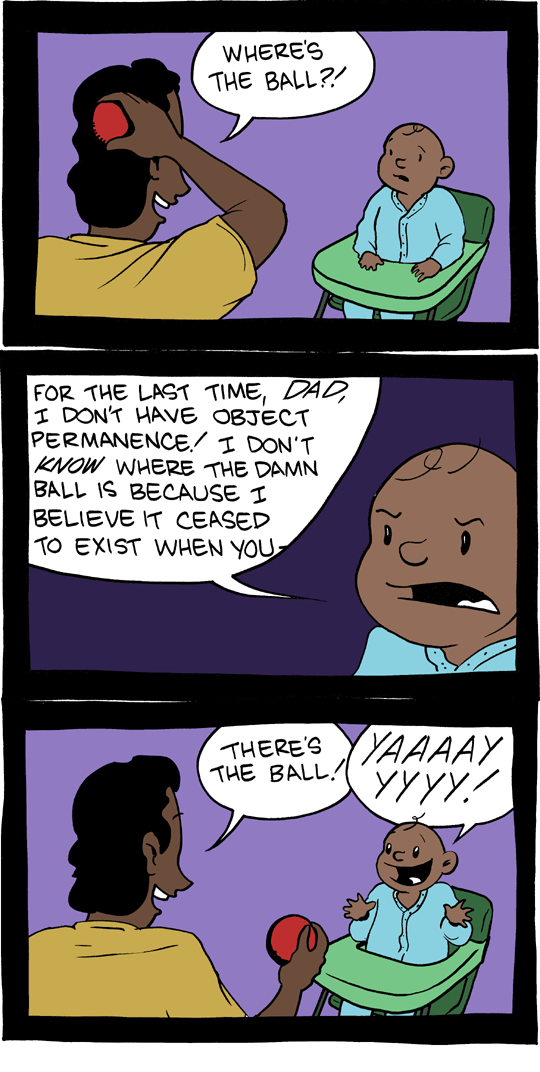This post is part of our ongoing series exploring classic experiments and theories in the history of psychological research.
Jean Piaget (1896-1980) was a Swiss developmental psychologist. While he made many contributions to the field, his most notable is his systematic study of cognitive development. Early psychologists assumed that infants saw the world as a “blooming, buzzing confusion” (William James); Piaget theorized that even the youngest infants were learning how to make sense of their environments. According to Piaget, knowledge is organized into different schemas, or sets of mental representations about the environment. When a new object or situation is encountered, it will either be assimilated into an existing schema (if it is consistent with that schema), or it will be accommodated by changing an existing schema (if it is inconsistent with that schema). Intellectual development occurs through a continual process of assimilation, new information, and accommodation (that is, updating existing schemas to reflect new knowledge). Piaget’s theory of cognitive development consists of four main stages, described below.
Stages of cognitive development:
Sensorimotor (0-2 years): Piaget framed the sensorimotor stage primarily in terms of infants’ motor development (as evidenced by the name). In this stage, infants learn through interacting with the world, first with simple reflexes such as rooting and sucking (at birth), and later with more intentional movements such as reaching and using objects to achieve goals. An important milestone of this stage is that of object permanence, in which infants understand that objects continue to exist even when they are out of sight. The sensorimotor stage ends when a child acquires language, usually around age two.

Preoperational (2-7 years): In the preoperational stage, children continue to acquire motor skills; however, this stage is characterized much more by children’s patterns of play and lack of logical thinking. As in the sensorimotor stage, children in the preoperational stage engage in very egocentric thought, in which they are unable to conceptualize another person’s point of view as being different from their own (e.g., “My favorite food is macaroni, so my friend Michael’s favorite food is also macaroni!”). In this stage, children also engage in a great deal of pretend/symbolic play (e.g., pretending that a cardboard box is a racecar; having tea parties with stuffed animals or imaginary friends).
Notable cognitive characteristics of this stage are centration and, relatedly, a lack of understanding of conservation. When children engage in centration, they attend only to one property of an object, ignoring the other properties and frequently drawing false conclusions. One way to observe children’s lack of conservation in this stage is to present them with two equal-sized glasses of equal amounts of liquid and then pour the liquid from one into a taller, skinnier glass. After having seen this, children will say that the tall, skinny glass contains more liquid than the shorter, wider one, simply because the tall glass is taller.
Concrete operational (7-11 years): When children reach the concrete operational stage, they become capable of logical thought under concrete circumstances, and an adult-like pattern of thinking begins to emerge. Though they cannot yet engage in hypothetical or abstract thought, they do exhibit a greater understanding of objects’ properties and relationships than children in the preoperational stage. Children in this stage are no longer egocentric – they can take on others’ viewpoints – and no longer exhibit centration, and they now understand conservation. Additionally, they are able to classify objects based on a variety of characteristics (e.g., color, number, mass, shape). According to Piaget’s theory, while children in the concrete operational stage have trouble making deductive conclusions (using a general principle to predict a specific outcome), they are able to use inductive reasoning (using several specific instances to find an overarching rule or characteristic).
Formal operational (11-16 years to adulthood): In this stage, the ability to think about abstract concepts has developed. People in the formal operational stage use deductive reasoning and can engage in logical, methodical problem-solving.
While Piaget’s theory has certainly been influential in the field of developmental psychology, it is not without its weaknesses. First and foremost, the theory suggests that development is a smooth, forward-only process; once children exhibit patterns of thinking that are typical of the next stage of development, they no longer exhibit patterns typical of the previous stage. Anyone who has experience with children can tell you this isn’t quite true – development doesn’t happen in a steady, linear manner, and children who exhibit thought processes characteristic of the concrete operational stage one day may exhibit preoperational thought processes the next. Second, Piaget’s theory assumes that all processes are domain-general, and that the ability to reason about one domain means that one can reason about other domains just as well. This theory also neglects other environmental factors that are critical in children’s development, such as language and other sociocultural factors. For other classic developmental theories, see work by Lawrence Kohlberg and Lev Vygotsky.